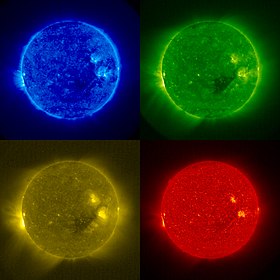Portal:Stars/Selected stars/3

The Sun is the star at the center of the Solar System. The Sun has a diameter of about 1,392,000 kilometers (865,000 mi) (about 109 Earths), and by itself accounts for about 99.86% of the Solar System's mass; the remainder consists of the planets (including Earth), asteroids, meteoroids, comets, and dust in orbit. About three-quarters of the Sun's mass consists of hydrogen, while most of the rest is helium. Less than 2% consists of other elements, including iron, oxygen, carbon, neon, and others.
The Sun's color is white, although from the surface of the Earth it may appear yellow because of atmospheric scattering. Its stellar classification, based on spectral class, is G2V, and is informally designated a yellow star, because the majority of its radiation is in the yellow-green portion of the visible spectrum. In this spectral class label, G2 indicates its surface temperature of approximately 5,778 K (5,505 °C), and V (Roman five) indicates that the Sun, like most stars, is a main sequence star, and thus generates its energy by nuclear fusion of hydrogen nuclei into helium.
